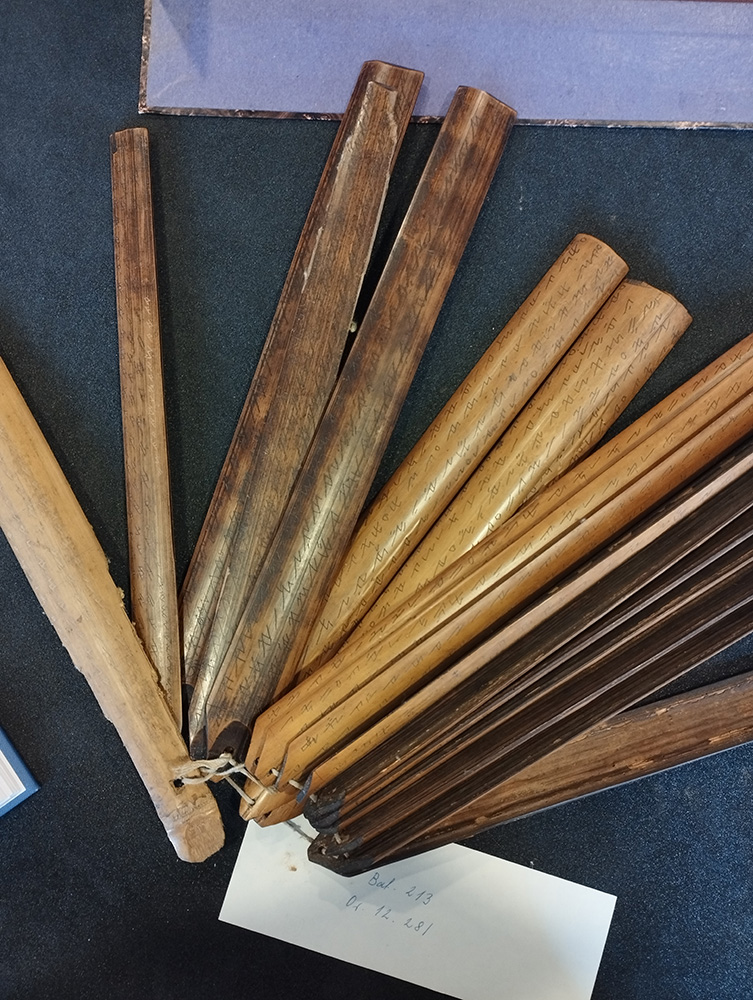Ulu Manuscripts at the Leiden University Library
In my quest to unravel the rich cultural tapestry of Sumatra, I have had the privilege of exploring the manuscript collection of UBL. With the generous support of the Lingling Wiyadharma Fellowship of the library's Scaliger Institute, I was able to study the Ulu manuscripts, handwritten books from the highland communities of southern Sumatra.
The manuscripts
The library has an extensive and varied collection of Ulu manuscripts, covering a wide range of materials and textual genres. This collection also includes transliterations and copies of Ulu manuscripts from various institutions, providing a comprehensive resource for students and scholars alike. The Ulu manuscript collection of UBL consists of 136 manuscripts: 36 bamboo manuscripts, one bark manuscript, and 99 paper manuscripts. This is a substantial collection of manuscripts, especially when compared to the National Library of the Republic of Indonesia, which has only 40 Ulu manuscripts.
The bamboo manuscripts include bamboo strips/gelumpai (bamboo strips held together with string) and bamboo stem/surat boloh (bamboo manuscripts with one or more internodes). Kaghas manuscripts are made of tree bark folded into a leporello shape. Paper manuscripts include sheets of paper, books, and leporellos with handwritten texts in Ulu script. From my observations, the Ulu manuscripts of UBL are well cared for and preserved. They are stored in specially designed boxes and folders. Moreover, depending on the type of manuscript, the staff hand out gloves before you handle the manuscripts.
Collection history
The origins of the Ulu manuscript collections at UBL trace back to the late 19th to mid-20th century AD. The acquisition of these manuscripts stemmed from various donations, with the initial collection efforts attributed to the linguist H.N. van der Tuuk in the 1880s. His contributions, including copies and transliterations archived under the shelfmarks Or. 3263 and Or. 3387, likely entered the library around mid-1896. Subsequent donations from individuals such as G.K. Niemann in the early 1900s, L.C. Westenenk in 1934 and 1935, M.G. Emeis, W.F. Lublink Weddik, and E.M. Uhlenbeck further enriched the collection. Another collection of bamboo manuscripts, notable for its size, was posthumously donated by J.A.W. van Ophuijsen (Or. 12.242 – Or. 12.263). Additionally, the collaborative efforts of M.A. Jaspan and P. Voorhoeve since 1969 have significantly contributed to the collection's expansion and preservation.
Enriching metadata
In my search for the Ulu manuscripts in the library's collections, I took a multi-pronged approach. First, I used the online catalogue. Using keywords, titles, and subject headings, I was able to identify some relevant material. However, the metadata and manuscript descriptions provided by UBL, particularly for the Ulu manuscripts, proved to be rather limited. Fortunately, I was able to use older printed catalogues such as the one compiled by Iskandar (1999) and Witkam's Inventory of the Oriental Manuscripts of the Library of the University of Leiden (2007) to locate all Ulu manuscripts.

Ulu Manuscripts
My work in identifying and describing these manuscripts will result in a catalogue. I hope that the metadata I create and share with the library will make it easier for future users to identify Ulu manuscripts in the collection. This, in turn, could encourage the use and study of this important cultural heritage of South Sumatra.
Tips for exploring the manuscript collection of UBL
For those who would like to explore the manuscript collection of UBL, I offer the following tips:
- Familiarize yourself with the library's online catalog and database to search for relevant manuscripts and materials related to your research interests.
- Utilize keywords, titles, and subject headings to narrow down your search and identify material that align with your research objectives.
- Take advantage of the library's digitization efforts to access rare and fragile manuscripts online, allowing for a more convenient and comprehensive study of the texts.
- Make use of the metadata and manuscript descriptions provided by the online and digitized catalogues to gain insights into the manuscripts' provenance, content, and thematic significance.
- Consider reaching out to the library staff and experts in Indonesian Studies for guidance and assistance in navigating the Ulu manuscript collection effectively.
Muhammad Haidar Izzuddin is an independent researcher from Palembang, Indonesia. In 2023, he was recipient of the Lingling Wiyadharma Fellowship of the Scaliger Institute, Leiden University Libraries. Email: mhaidarizudin2015@gmail.com